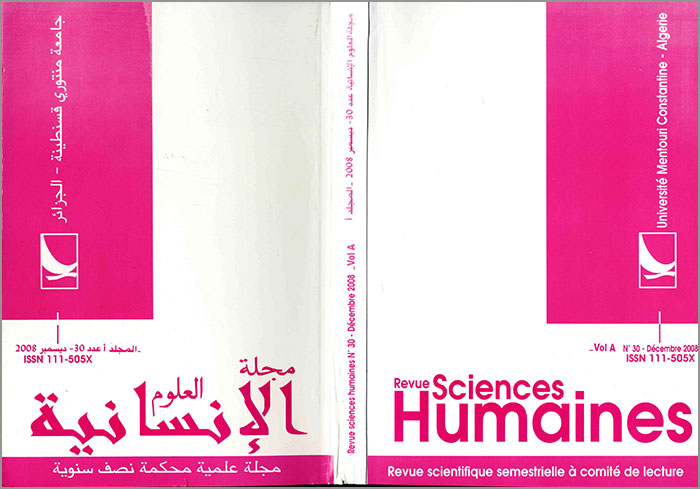ORTHOGRAPHIC CROSSLINGUISTIC INFLUENCE ON THIRD LANGUAGE PRONUNCIATION: A CASE OF ADVANCED STUDENTS READING FOR A BA DEGREE IN ENGLISH
الملخص
This paper is a contribution to the recent rationalist, multidimensional, and multidirectional trend in explaining the notion of language transfer, now “crosslinguistic influence”, as a conscious problem solving process rather than as an unconscious and mechanistic operation. It also provides support to those who believe that the role of a second language is no less important in shaping the learner's interlanguage. This is done through analysing some of the pronunciation errors of three groups of BA students of English: those that are the result of an orthographic crosslinguistic influence from French, their second standard language after Arabic.
التنزيلات
المراجع
-Pennington, M. C. (1996) Phonology in English Language Teaching. Edison Wesley, Longman. P 186.
-Hanna, P. R., Hodges, R.E. & Hanna, J. S. (1971) Spelling: Structure and Strategies. Boston, Houghton Mifflin.
-Crystal, D. (1987) The Cambridge Encyclopaedia of Language. Cambridge University press.
-Thorstad, G. (1991) The effect of orthography on the acquisition of literacy skills. British Journal of Psychology, 82 527-537.
-Spencer, K. (2002) English spelling and its contribution to illiteracy: word difficulty for common English words. Reading Literacy and Language, 36 16-25.
-Cook V. (1997) L2 users and English spelling. Journal of Multilingual and Multicultural Development, 18, 474-488.
-Bartelt, G. (1989) The interaction of multilingual constraint, in H.W. Dechert & M. Raupach. Interlingual Processes, pp. 151-177. Tübingen: Gunter Narr.
-Ringbom, H. (1982) The influence of other languages on the vocabulary of foreign language learners, in Nickel, G. & Nehls, D. (eds.), Error Analysis, Contrastive Analysis and Second Language Learning, Heidelberg: IRAL
-Azevedo, M. M. (1978) Identifying Spanish interference in the speech of learners of Portuguese. The Modern Language Journal, 62 (1-2), 18-23.
-Fitzgerald, W. A. (1978) Nativization and second language acquisition: A study of negation. Unpublished thesis. Carbondale: Southern Illinois University.
-Sharwood Smith, M. (1994) Second Language Learning: Theoretical Foundations. Harlow: Longman
-Zampini, Mary L. (1994) The Role of Native Language Transfer and Task Formality in the Acquisition of Spanish Spirantization. Hispania 77.
-Lado R. (1957) Linguistics across Cultures. University of Michigan press. P2.
-Jackobovits L.A. (1969) Second Language Learning and Transfer Theory: A Theoretical Assessment. Language Learning 19, 55.
-Corder, S. Pit. (1981) Error Analysis and Interlanguage. Oxford University Press. P 101.
-Osgood, C. E. (1953) Method and Theory in Experimental Psychology. New York: Oxford University Press.
-Flege, J. (1995) Second language speech learning: Theory, findings and problems. In Speech Perception and Linguistic Experience: Theoretical and Methodological Issues. Timonium, MD: York Press.
-Kellerman, E. and Sharwood Smith, M. (1986) Cross-linguistic Influence in Second Language Acquisition. Pergamon Institute of English. P1.
-Corder, S. Pit. (1983) A Role for the Mother Tongue. In Gass and Selinker, Language Transfer in Language Learning, Rowley, MA, Newbury House. P 86.
-Wode, H. (1986) Language Transfer: A Cognitive Functional and Developmental view. In Kellerman E. and Sharwood Smith. 1986. Cross-linguistic Influence in Second Language Acquisition. Pergamon Institute of English. P 174.
-Odlin, T. (1989) Language Transfer. Cambridge: Cambridge University Press. P151.
-Kellerman, E. (1977) Transfer and non-transfer: Where are we now? Paper given to a conference in Bern.
-Kellerman, E. (1978) Giving learners a break: native language intuitions as a source of predictions about transferability. Working Papers on Bilingualism 15: 59-92.
-Sharwood Smith M. (1979) Strategies, Language Learning, and the Simulation of the Second Language Learner’s Mental Operations. Interlanguage Studies Bulletin V 4 n° 1.
-James, J. (1977) Language transfer reconsidered. Interlanguage Studies bulletin 2, 12-13.
-Sjohlm, M. A. (1976) Comparison of the test results in Grammar and Vocabulary between Finnish and Swedish Speaking Applicants. AFTIL 5
-De Lattre, P. (1957) La question des deux "a" en français. The French Review 31, 2, 141.
-Roach, P. (1988) English Phonetics and Phonology. Cambridge University Press.
-Gass, S. & Selinker, L.(1994) Second Language Acquisition: An Introductory Course. Hillsdale, NJ: Lawrence Erlbaum Associates, Publishers. P 100.
-Ellis, R. (1994) The Study of Second Language Acquisition. Oxford: Oxford University Press.
The word “English" is written with final “e” as cited in Pennington.
“Learner language” is synonymous to “interlanguage”.
Contenu des modules de la licence d'enseignement de la langue anglaise (a syllabus suggested by the Ministry of Higher Education in the late seventies).
The diacritic marks over some letters in French seem to make no difference for the learners when being inspired in their performance of English












